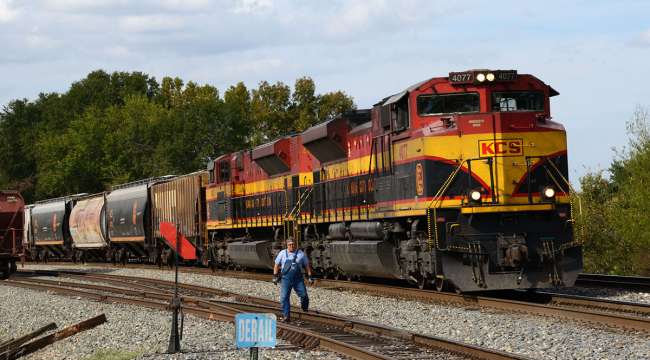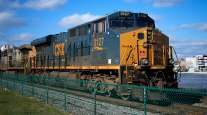Kansas City Southern Profits Up Nearly 12%, Continuing Streak of Wins for Rail

Kansas City Southern continued the red-hot results from railroad freight carriers in the second quarter, with its profit growing 11.9%, slightly beating the consensus analyst forecast.
The rail freight carrier earned $134.4 million in profits or $1.27 per share. The Bloomberg News consensus forecast of industry analysts called for $133.5 million or $1.27. The EPS beat was by fractions of a cent.
One year ago, the numbers were $120.1 million or $1.11.
Revenue grew 15% year-over-year to $656.4 million. Operating income — after expenses were deducted from revenue — increased 9% to $239 million.
“We are pleased to report record second-quarter revenues and earnings per share as well as an all-time record quarterly operating income,” Kansas City Southern CEO Patrick Ottensmeyer said. “Carloads were up in four out of six commodity groups, driving strong second-quarter revenue growth of 15%. Our revenue performance featured strength in Energy, Automotive and Chemicals & Petroleum, as higher commodity prices, Mexican automotive production and the emergence of Mexican energy reform supported growth.”
Intermodal, which grew at competitors CSX, Canadian Pacific and Union Pacific, didn’t fare as well at Kansas City Southern. Revenue dropped 1% to $90.6 million and carloads dropped 1% to 243,100 while revenue per carload remained relatively flat year-over-year.
Energy transportation, consisting of coal, fracking and crude oil, saw a huge spike in business last quarter. Revenue jumped 90% to $70.5 million, carloads surged 41% to 69,600 and revenue per carload jumped 35% to $1,013.
Chemical, petroleum and plastics transportation revenue went up 13% to $138.8 million. Carloads grew 6% to 71,500 and revenue per carload increased 7% to $1,941.
Revenue from industrial and consumer products transportation grew 9% to $148.6 million. Carloads increased 4% to 82,700 and revenue per carload rose 5% to $1,797.
The operating ratio deteriorated to 63.5% compared with 61.3% in second-quarter 2016. A lower percentage is better because it means operating expenses didn’t eat as much into top-line revenue as a previous period of time.
Through the first half of 2017, profits grew 23% to $280.9 million and revenue increased 13% to $815.9 million. However, the operating ratio deteriorated 50.2 basis points to 64.5%.




